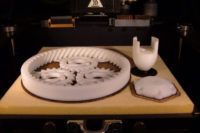Participating in the Olympics provides an athlete with a lifetime of memories. A small percentage of athletes are skilled enough to receive a gold, silver or bronze medal. Those who fall short of the winner’s circle hold firm to the great achievement of reaching the Olympics.
Members of Japan’s 2012 men’s fencing team fall into the former category as silver medalists. Hard work and talent were the main reasons for the team’s success. A third reason was 3D printing.
Tsukuba University, located in Japan’s Kanto region, conducts research and development in sports equipment, training and conditioning. For the 2012 Olympics, professor Norihisa Fujii and sports biomechanics researcher Osamu Takeda of the school’s Faculty of Health and Sport Sciences worked closely with Japan’s fencing team to optimize its performance.
They focused on the sword’s hilt, which must be customized to perfectly fit the fencer’s hand. The hilt consists of a grip, a hand guard and a pommel (the fastener that attaches the grip to the blade). A hilt that’s even slightly improperly shaped can place the fencer at a major disadvantage and significantly increase the chance of him losing.
Fujii did a three-dimensional scan of the fencers’ equipment to obtain polygon data. He then incorporated this data into a 3D CAD file and uploaded it into an Objet350 Connex 3D printer. Takeda oversaw the printing of 70 plastic prototype hilts for the four-person team. Minute variations were made to each hilt based on the fencer’s feedback.
The Connex350 prints in 16-micron, high-resolution layers on a 350-by-350-by-200-millimeter build tray. It also features PolyJet technology, which prints up to 14 material properties simultaneously in a single part.
The final custom hilts were printed in April 2012, three months before the Olympics took place in London. Each fencer on the Japanese team brought five spare hilts to the Olympics, a first in fencing history.
Before 3D printing, there was only one type of fencing hilt in the world, and each competitor had to personally file the hilt to customize its fit and achieve a nonslip surface. If the sword ended up breaking, it was almost impossible to get another one with the same fit.
“3D printers have a long history with the sports world, spanning
everything from customized running shoes to end-use parts for bikes and snowmobiles,” notes Jon Cobb, executive vice president of marketing for Stratasys Ltd. “Their fast turnaround time means that the athlete can try several design iterations until the equipment exactly matches personal preferences.”
For more information on 3D printers, call 800-801-6491 or visit www.stratasys.com.





